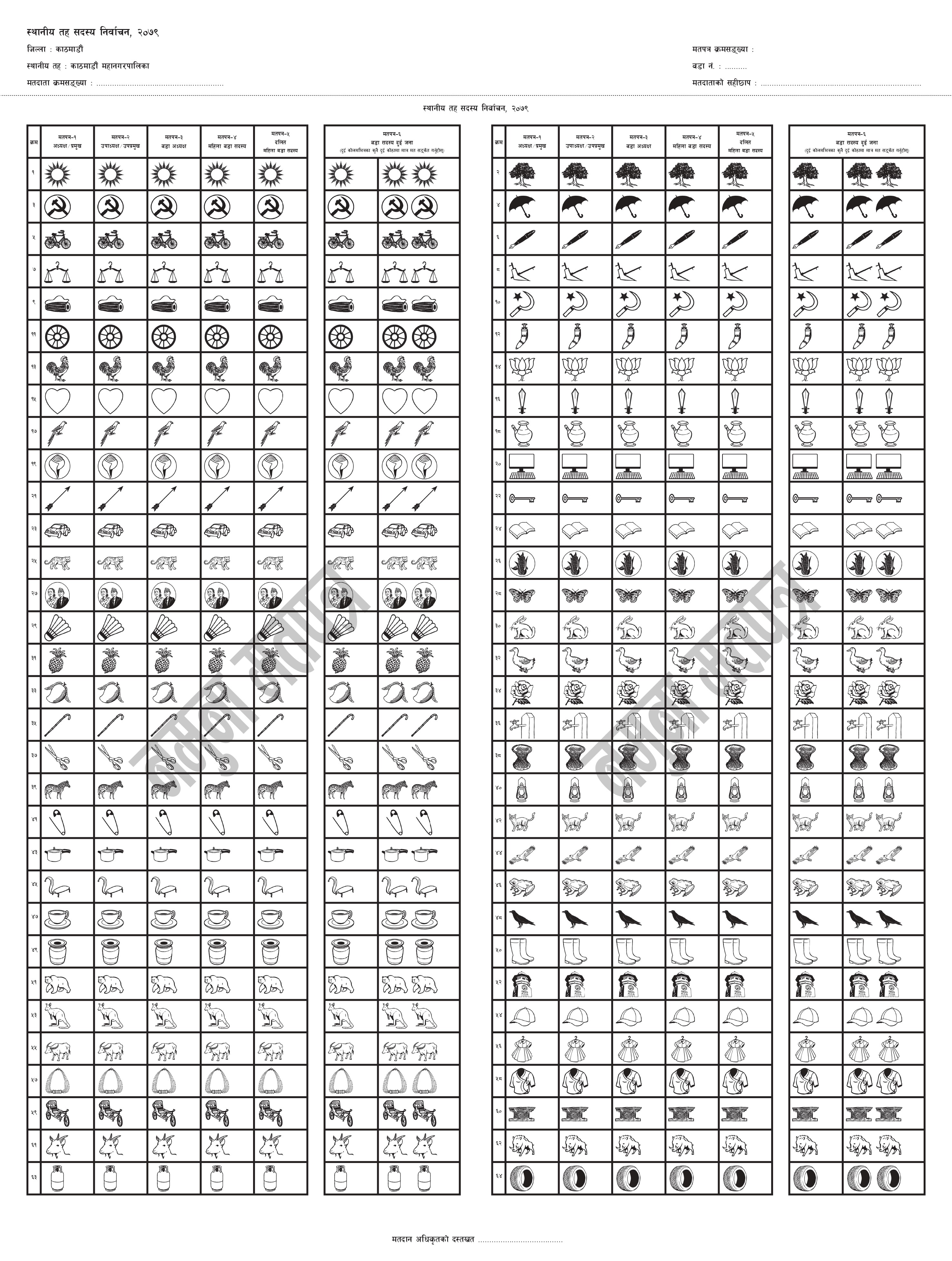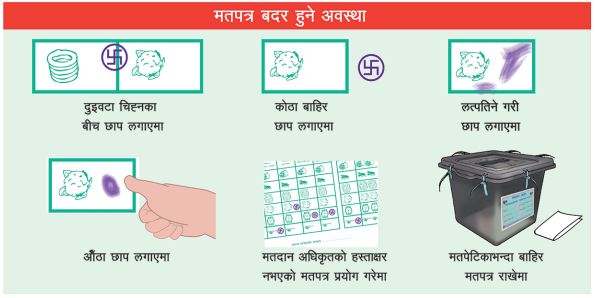
Explainers
9 MIN READ

Here’s a handy list of things to keep in mind, especially for first-time voters, while voting in the 2022 local election on Friday, May 13.

Tomorrow, May 13, Nepal will be holding its local level elections — the second one since the country adopted a federal structure with the 2015 constitution. The Election Commission reports that a total of 1,77,33,723 voters have registered to participate in the upcoming election. Of this number, around 23,05,992 are first-time voters.
Surya Prasad Aryal, the information officer and assistant spokesperson for the Election Commission, shared that they have three key targets for the election:
1. Participation. Everyone should be able to exercise their right to elect and be elected.
2. Reduction of invalid votes. People must know how to cast their votes correctly.
3. Making an informed choice. Voters should make informed and educated choices instead of riding political hype trains.
Elections in Nepal have always had a very high percentage of invalid votes, with numbers as high as 21 percent in Biratnagar and 17 percent in Lalitpur during the former elections. During the 2017 elections, the Election Commission launched a door-to-door voter awareness campaign. No such effort has been made this time around as those volunteers were criticized for being partisan. As no alternatives have been instituted, there are widespread fears that the number of invalid votes could rise, given that the voting ballots are relatively longer and that a large number of voters are going to be voting for the first time.
For first-time voters and those who need a refresher before going to the booth, The Record provides a brief overview of everything you need to keep in mind while voting.
The day before
There are a few things you need to have in order on May 12 before you go vote on Friday. The most important thing you need to do is make sure that you are a registered voter. You can check if your name is on the voter list by clicking here.
Once you have confirmed that you are indeed registered to vote, make sure you find and keep your voter card with you. You can get your voter ID from your nearest polling station itself on Thursday, May 12. But in case you have misplaced your voter card or have forgotten to get it, you can still show up at your local polling station with your Nepali citizenship card or other documents like the national identity card, passport or a land/home ownership certificate.
“But this is only for those who have registered to vote and don’t have their voter ID. If you haven’t registered to vote in the first place, showing up with your citizenship card won’t help,” said Aryal.
You should also figure out where your local polling centers are. Centers are usually public spaces such as local schools and other communal spaces in the area. There are a total of 10,756 polling centers spread across the country. You can check the polling center locations for your district and ward here or call your local ward office.
Voting day
Before heading out to vote on Friday, May 13, make sure you’ve had a solid meal and are carrying a bottle of water. Wear something comfortable as you might be lining up to vote for a long time, especially if you’re in a heavily populated area. Make sure that the clothes you are wearing do not have any overt symbolism related to the political parties or any candidate. Also, the Election Commission has asked voters not to show up drunk to vote. Anyone who displays signs of intoxication will not be allowed to enter the voting center. Note that you are not allowed to use your mobile phone camera or any other camera inside the voting premises. You are also not allowed to carry any weapons, sample ballot papers, lighters or any flammable material.
Voting takes place from 7am to 5pm so do not get there too early or too late.
There are a few things you need to do once you have located and arrived at your polling center on voting day.
Given that the nation is still recovering from the pandemic, the election might give rise to a new wave of COVID-19 infections. “Voters need to take COVID-19 precautions. Wear masks, maintain social distancing, and sanitize your hands,” said Aryal.
Aside from being wary of the coronavirus, prospective voters must line up in their respective queues. Every polling center has dedicated gender-specific lines for people who identify as male or female. Additionally, Aryal shared that there are also provisions where the elderly, people with disabilities, pregnant women, and non-binary people are not required to wait in line.
Once your turn does come, you will be required to show your identifying papers, i.e. your voter id and/or citizenship card. Once you are verified as a registered voter, you are marked with a special permanent marker on your left-hand thumb — right where your skin and nail meet.
You are then taken to receive your ballot paper. Once you confirm your understanding of the ballot, the concerned authority will proceed to tear off a ballot paper for you to vote with. As a voter, you will need to make sure that the ballot paper you received includes the signature of the election officer.
“If the ballot is missing the sign of the election officer, even if you do vote correctly, the ballot will still be counted as an invalid vote,” said Aryal.

Finally, voters will proceed to enter a private polling booth where you are required to place a swastika stamp on each of the seven columns of the box with the election symbol of the candidate of your preference (see below for more information on how to place your stamps). The stamp will be double-sided but should the ink dry on both ends. Voters can use stamp pads that will be available at the booths.
Once you have carefully selected your preferred candidates, you are required to fold up your ballot and slot it inside the ballot box. Make sure that the ink from your stamps has dried properly before you fold in order to avoid any unwanted imprinting that might invalidate your vote.
After you are done voting, voters are requested not to linger about the polling center and return to their residences.
Navigating the ballot paper
This time around, the ballot paper is quite long and complicated. Voters will need to carefully scrutinize the ballot and make sure that their stamps are placed in the correct row and column.

Each ballot paper will have seven columns – one column each for mayor (metropolitan, sub-metropolitan cities) or chairperson (municipality/rural municipality) (अध्यक्ष / प्रमुख), deputy mayor or deputy chairperson (उपाध्यक्ष / उपप्रमुख), ward chair (वडा अध्यक्ष), woman ward member (महिला वडा सदस्य), Dalit woman ward member (दलित महिला वडा सदस्य), and one column each for two ward members. Keep in mind that the final column will have two election symbols but you only have to stamp it once.
Once you’ve identified the columns, you need to carefully go through the plethora of rows until you find the box that has the election symbol of your preferred candidate/party. Since ballot papers do not include the names of the candidates that are running for the different positions, it is up to you to be aware of the election symbol of your candidate. For instance, established political parties like Nepali Congress and the CPN-UML have the tree and the sun symbols, respectively. The Maoist symbol is the hammer and sickle while independent candidates like Balen Shah in Kathmandu and Ganesh Paudel in Pokhara have received the walking stick (लौरो) symbol.
Things to keep in mind so you do not invalidate your vote
Finally, some quick pointers to keep in mind so that your ballot does not get invalidated:
You are only allowed to stamp once next to each electoral symbol for each of the first 5 columns (mayor, deputy mayor, ward chair, woman ward member, and Dalit woman member). Any ballots that have stamps on two or more electoral symbols in the same column will be considered invalid.
For the final two columns, for the remaining two ward members, voters are allowed to stamp in any two boxes on either column. This means that you can stamp on two different boxes on the same column, as well as on different columns. Any more than two stamps and your ballot is invalidated. Keep in mind that the last column has two symbols but you still only have to stamp it once.
Stamping in between boxes, rows, and columns, and stamping outside of columns will invalidate your vote.

Ballots that are missing the signature of the election officer will also be considered invalid, so make sure to check for the signature at the bottom of the ballot paper.
Take care while folding the ballot paper. Make sure that the ink is dry. Any smudges or ink on different columns will invalidate your vote.
Once you are done voting and have foled the ballot paper, place it carefully inside the ballot box. Any ballots left outside the box will be rendered invalid.

Sajeet M. Rajbhandari Sajeet is a Media Studies undergraduate and is currently reporting for The Record.


COVID19
Features
3 min read
The government’s latest set of decisions has baffled experts and the public alike
The Wire
Features
16 min read
11 have been sentenced to life in prison while the Tharu community in Tikapur continues to pay the price for the horrors of 2015
COVID19
News
5 min read
A daily summary of all Covid19 related developments that matter
COVID19
Features
5 min read
All safety precautions have been relaxed in Nepal but instead of rising, Covid-19 cases are falling, perplexing the medical community.
News
3 min read
Leaders across the political spectrum react to hastily enforced ordinances
COVID19
7 min read
The government is responding to this crisis with make-do solutions
Explainers
4 min read
Despite showing positive signs, the army needs to come under CIAA’s jurisdiction to gain more credibility